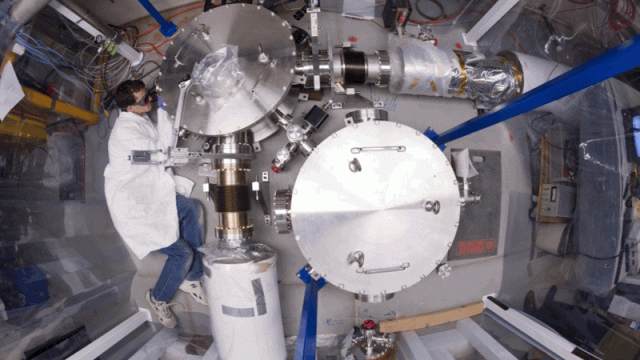A controversial experiment at Fermilab designed to hunt for signs that our universe may really be a hologram has failed to find the evidence it was seeking, the laboratory has announced.
It’s called the Holometer (short for “Holographic Interferometer”), and it’s the brainchild of Fermilab physicist Craig Hogan. He dreamed up the idea in 2009 as a way to test the so-called holographic principle.
Back in the 1970s, a physicist named Jacob Bekenstein showed that the information about a black hole’s interior is encoded on its two-dimensional surface area (the “boundary”) rather than within its three-dimensional volume (the “bulk”). Twenty years later, Leonard Susskind and Gerard ‘t Hooft extended this notion to the entire universe, likening it to a hologram: our three-dimensional universe in all its glory emerges from a two-dimensional “source code”. New York Times reporter Dennis Overbye has likened the holographic concept to a can of soup. All the “stuff” of the universe, including human beings, makes up the “soup” inside the can, but all the information describing that stuff is inscribed on the label on the outside boundary.
Susskind initially considered it to be a metaphor, but then crunched some more numbers and concluded that the notion made literal sense as well: the 3D universe really is a projection of 2D information at the boundary.
The holographic principle has since become one of the most influential ideas in theoretical physics, yet many believe it to be untestable, at least for now. (It would require probing black holes up-close, a daunting prospect even if we had the technology to do so.) Hogan decided to try anyway. The Holometer looks for a special kind of holographic noise — a kind of quantum jitter in space-time — using a fairly humble-looking set-up: an array of lasers and mirrors in a dank underground tunnel, with the control room housed in a trailer. Nobody ever said physics was glamorous. Per Symmetry:
The Holometer uses a pair of laser interferometers placed close to one another, each sending a 1-kilowatt beam of light through a beam splitter and down two perpendicular arms, 40 meters each. The light is then reflected back into the beam splitter where the two beams recombine.
If no motion has occurred, then the recombined beam will be the same as the original beam. But if fluctuations in brightness are observed, researchers will then analyse these fluctuations to see if the splitter is moving in a certain way, being carried along on a jitter of space itself.
It’s an extremely difficult thing to detect, because there are so many other things that could be mistaken for a jittery signal, including wind and traffic noise. The early signs weren’t promising when the first preliminary results (based on an hour or so of data) came in back in April. So it’s probably not all that surprising that the final analysis proved equally fruitless.
The $US2.5 million experiment was controversial from the get-go, with the inventors of the holographic principle counting among the naysayers. So expect to see a bit of schadenfreude making the rounds of the theoretical physics community today. As Sabine Hossenfelder, a physicist at Nordita in Sweden and one of the more outspoken critics of the experiment, tweeted: “Holometer results are out: Nothing. Not surprising, as the idea underlying it is nonsense.”
But Hogan remains relentlessly optimistic. After all, a null result is still an advance of sorts, and it’s just his particular theoretical model of how this might work that has been ruled out. “This is just the beginning of the story,” he told Symmetry. “We’ve developed a new way of studying space and time that we didn’t have before. We weren’t even sure we could attain the sensitivity we did.”
References:
Bousso, Raphael. (2002) “The Holographic Principle,” Reviews of Modern Physics 74 (3): 825 — 874
Chou, Aaron S. et al. (2015) “Search for space-time correlations from the Planck scale with the Fermilab Holometer,” arXiv. [Preprint]
Susskind, Leonard. (1995) “The World as a Hologram,” Journal of Mathematical Physics 36 (11): 6377 — 6396.
[via Symmetry]
Images courtesy of Fermilab.
